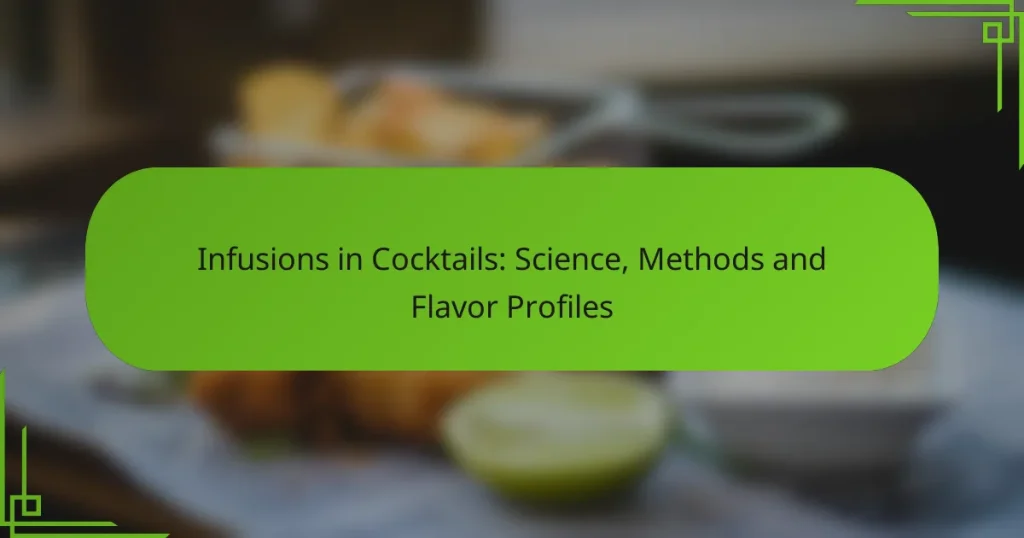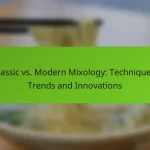Infusions in cocktails offer a creative way to enhance flavors, textures, and visual appeal, allowing bartenders to craft unique drinks that resonate with local tastes. By utilizing various methods to extract flavors from ingredients like herbs, fruits, and spices, the infusion process can significantly impact the cocktail’s overall profile. Selecting the right combination of ingredients is essential for creating complex and enjoyable flavor experiences.
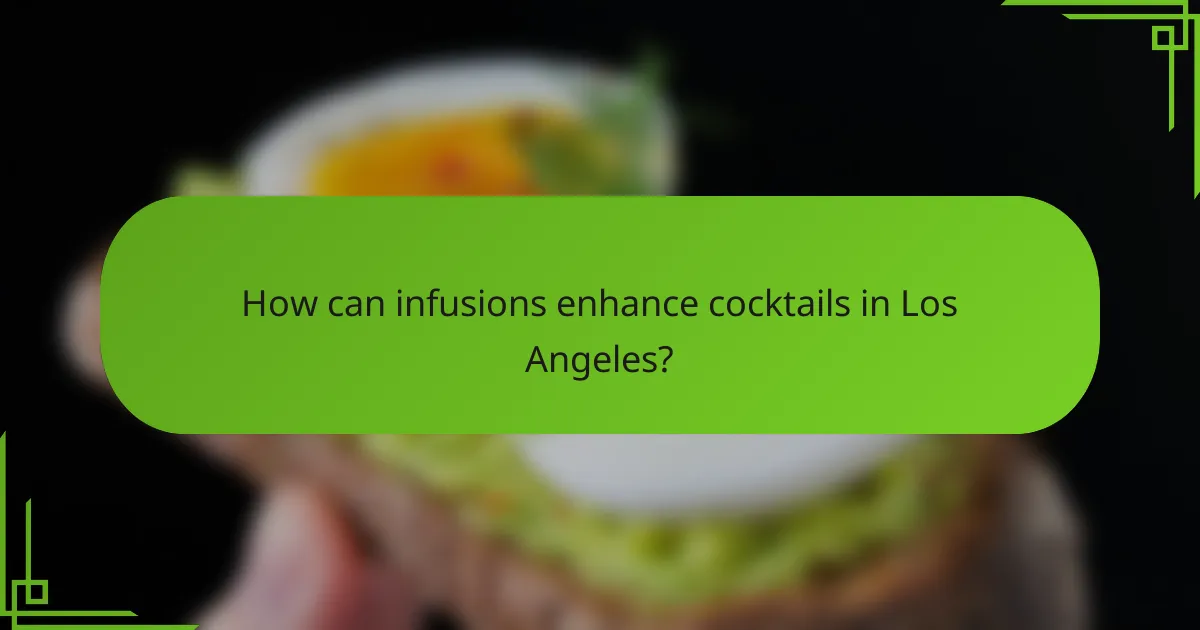
How can infusions enhance cocktails in Los Angeles?
Infusions can significantly elevate cocktails in Los Angeles by introducing complex flavors, unique textures, and vibrant colors. By using various ingredients like herbs, fruits, and spices, bartenders can create distinctive drinks that reflect local tastes and trends.
Flavor enhancement through botanical infusions
Botanical infusions add depth and complexity to cocktails by incorporating flavors from herbs, spices, and flowers. For instance, infusing gin with botanicals like rosemary or lavender can create a refreshing twist on classic recipes. When experimenting, consider steeping for a few hours to a couple of days, depending on the strength of the ingredient.
To achieve the best results, use high-quality spirits as a base and fresh, organic botanicals whenever possible. This ensures that the infusion captures the full essence of the ingredients, enhancing the overall cocktail experience.
Unique textures from fruit infusions
Fruit infusions can introduce unique textures to cocktails, making them more enjoyable. For example, infusing vodka with fresh strawberries or peaches can create a smooth, fruity base that complements other ingredients. The infusion process typically takes a few days, allowing the flavors to meld while maintaining the fruit’s natural essence.
When selecting fruits, consider seasonal options available in Los Angeles, such as citrus or berries, to enhance freshness. Avoid over-infusing, as this can lead to overly sweet or muddled flavors.
Visual appeal with color-infused spirits
Color-infused spirits not only enhance the visual appeal of cocktails but also signal flavor profiles to the drinker. Infusing spirits with colorful ingredients like hibiscus flowers or blueberries can create stunning drinks that catch the eye. The infusion process can take anywhere from a few hours to a couple of days, depending on the desired intensity.
To maximize visual impact, layer different colored infusions in a glass or use clear spirits to showcase the vibrant hues. This technique not only makes the cocktail more attractive but also adds to the overall drinking experience.

What methods are used for cocktail infusions?
Cocktail infusions utilize various methods to extract flavors from ingredients into spirits or mixers. The choice of method affects the infusion’s speed, flavor intensity, and overall profile.
Cold infusion techniques
Cold infusion involves steeping ingredients in alcohol at low temperatures, typically over several hours to days. This method preserves delicate flavors and aromas that might be lost with heat.
Common cold infusion ingredients include herbs, fruits, and spices. For example, infusing gin with cucumber or mint can create refreshing cocktails. A general guideline is to let the mixture steep for 24 to 48 hours, tasting periodically to achieve the desired flavor.
Heat infusion processes
Heat infusion accelerates the extraction of flavors by applying warmth, often through methods like simmering or using a sous-vide technique. This approach can yield a more robust flavor profile in a shorter time frame, usually within minutes to a couple of hours.
When using heat, be cautious with delicate ingredients that may lose their essence. For instance, infusing bourbon with vanilla beans can be done by gently heating the mixture for about 30 minutes. Always allow the infusion to cool before straining.
Vacuum infusion methods
Vacuum infusion employs reduced pressure to enhance the extraction process, allowing flavors to be drawn out quickly without heat. This method can be particularly effective for fragile ingredients that might otherwise degrade under heat.
Using a vacuum chamber, you can infuse spirits in a matter of minutes. For example, infusing vodka with berries can be done in as little as 10 minutes. Ensure that the vacuum seal is tight to maximize flavor extraction and minimize oxidation.
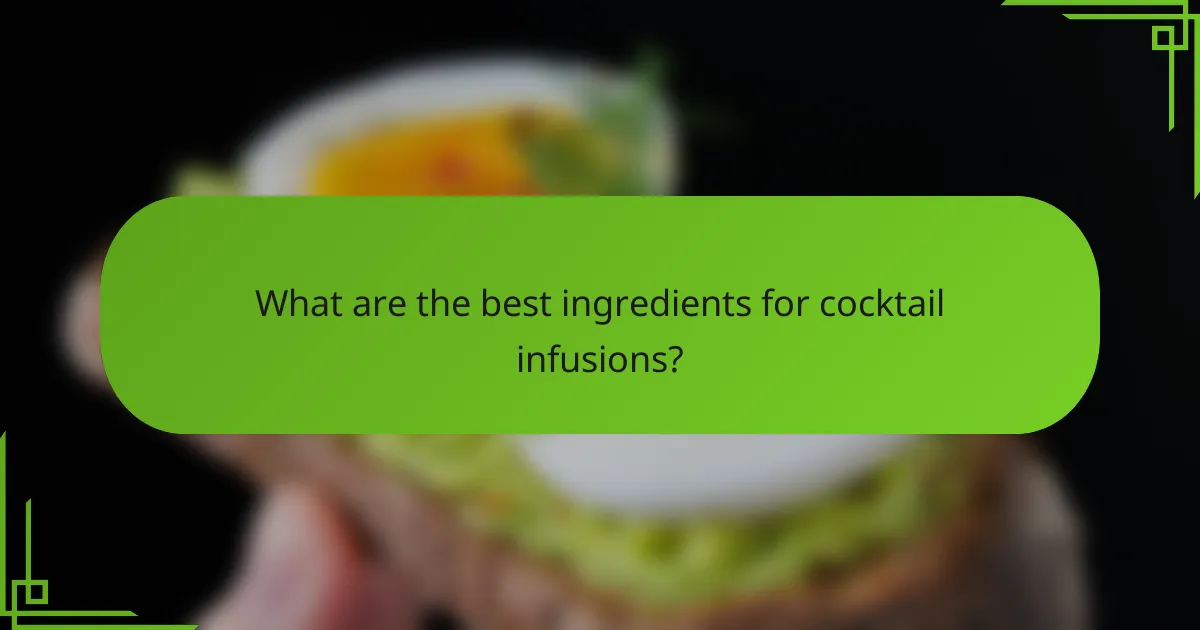
What are the best ingredients for cocktail infusions?
The best ingredients for cocktail infusions include herbs, spices, fruits, and vegetables, each contributing unique flavors and aromas. Selecting the right combination can enhance the overall taste profile of your cocktails, making them more complex and enjoyable.
Herbs and spices for aromatic profiles
Herbs and spices are essential for creating aromatic profiles in cocktail infusions. Common choices include basil, mint, rosemary, and thyme, which can add freshness and depth. Spices like cinnamon, cardamom, and star anise introduce warmth and complexity.
When infusing with herbs and spices, consider the infusion time; shorter infusions (a few hours) can yield lighter flavors, while longer infusions (up to several days) intensify the taste. Always taste periodically to avoid overpowering the base spirit.
Fruits for sweetness and acidity
Fruits are excellent for adding sweetness and acidity to cocktail infusions. Citrus fruits like lemons, limes, and oranges provide bright, zesty notes, while berries such as strawberries and raspberries contribute natural sweetness. Stone fruits like peaches and cherries can add a rich, juicy flavor.
For optimal results, use fresh, ripe fruits and adjust the infusion time based on the fruit type. Generally, citrus can infuse quickly (within hours), while denser fruits may require a few days to fully extract their flavors.
Vegetables for savory notes
Vegetables can introduce savory notes that balance the sweetness of fruits in cocktail infusions. Ingredients like cucumber, bell peppers, and tomatoes can add refreshing and earthy flavors. Root vegetables such as beets and carrots can contribute sweetness and depth.
When using vegetables, ensure they are fresh and clean. Infusion times may vary; lighter vegetables like cucumber can infuse in a few hours, while denser options may need longer. Always strain the infusion well to avoid unwanted textures in your cocktails.

How do infusion times affect flavor profiles?
Infusion times significantly influence the flavor profiles of cocktails, determining how subtle or intense the flavors become. Shorter infusion times typically yield delicate notes, while longer infusions extract bolder, more pronounced flavors.
Short infusion times for subtle flavors
Short infusion times, generally ranging from a few minutes to a couple of hours, are ideal for achieving subtle flavors in cocktails. This method allows for a gentle extraction of flavors, which can enhance the drink without overpowering the base spirit.
For instance, infusing vodka with fresh herbs like basil or mint for about 30 minutes can impart a light, refreshing taste. It’s essential to monitor the infusion closely to avoid bitterness or overwhelming flavors.
Long infusion times for intense flavors
Long infusion times, often extending from several hours to days, are used to create intense and complex flavor profiles. This approach is suitable for ingredients that require more time to release their full potential, such as dried fruits, spices, or robust botanicals.
For example, infusing rum with dried cherries for 48 hours can result in a rich, deep flavor that transforms the cocktail experience. However, caution is advised, as excessive infusion can lead to overly strong or unbalanced flavors.
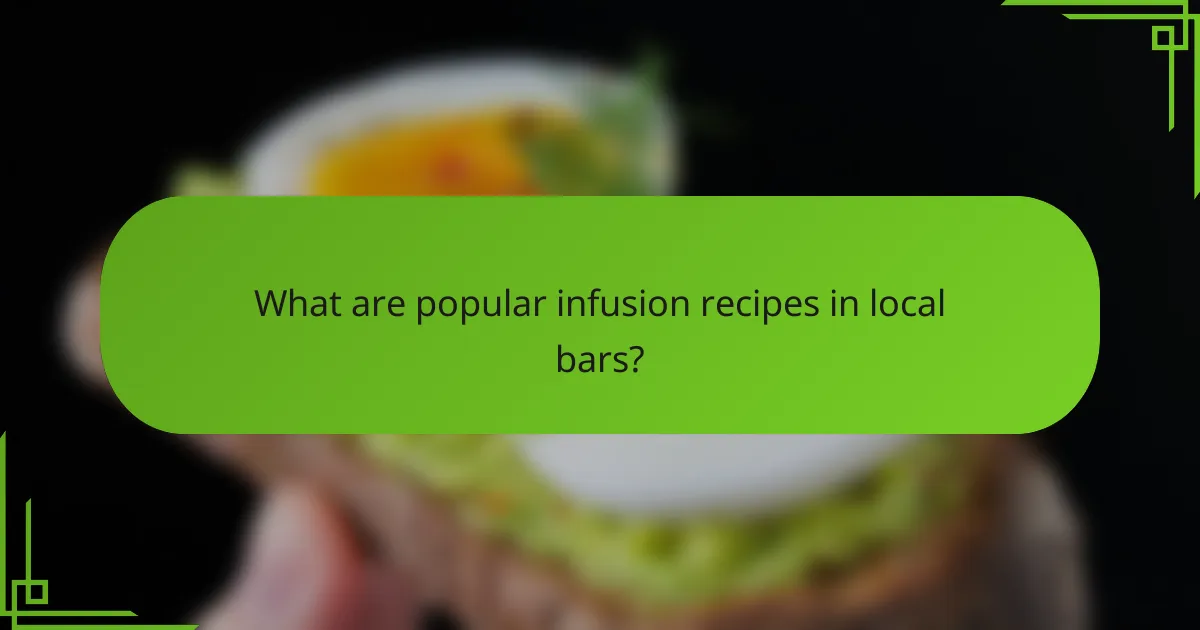
What are popular infusion recipes in local bars?
Popular infusion recipes in local bars often highlight unique flavors that enhance cocktails. These infusions can include a variety of ingredients, allowing bartenders to create signature drinks that stand out.
Lavender-infused gin cocktails
Lavender-infused gin cocktails offer a floral twist to traditional gin drinks. To make this infusion, steep dried lavender buds in gin for several days, then strain to remove the solids. This infusion pairs well with tonic water or lemon juice, providing a refreshing and aromatic experience.
When crafting a lavender cocktail, consider balancing the floral notes with citrus or herbal elements. A simple recipe could include lavender-infused gin, fresh lemon juice, and a splash of soda for a light, effervescent drink.
Spicy jalapeño tequila infusions
Spicy jalapeño tequila infusions add a kick to cocktails, appealing to those who enjoy heat. To create this infusion, slice fresh jalapeños and add them to tequila, allowing the mixture to steep for a few days until the desired spice level is reached. Strain before use to remove the peppers.
These infusions work well in margaritas or spicy tequila sunrises. Start with a small amount of jalapeño to gauge the heat, as it can intensify over time. A common pitfall is over-infusing, which can lead to an overpowering flavor.
Citrus-infused rum drinks
Citrus-infused rum drinks bring brightness and zest to cocktails. Infuse rum with a mix of citrus peels, such as orange, lemon, and lime, for a vibrant flavor profile. Steep the peels in rum for about a week, then strain to remove solids.
This infusion is versatile and can be used in various cocktails, including mojitos or daiquiris. Adjust the infusion time based on the desired intensity, and consider using fresh citrus juice alongside the infused rum for an extra burst of flavor.

What equipment is needed for cocktail infusions?
To create cocktail infusions, you need a few essential pieces of equipment that facilitate the extraction of flavors. The most important tools include glass jars, a fine mesh strainer, and measuring tools to ensure accuracy in your recipes.
Glass jars
Glass jars are crucial for infusing ingredients, as they allow you to see the infusion process and monitor the color and clarity of the liquid. Choose jars with airtight seals to prevent oxidation and contamination. Common sizes range from 500 ml to 1 liter, depending on the volume of infusion you plan to make.
Fine mesh strainer
A fine mesh strainer is essential for separating solid ingredients from the infused liquid. This tool ensures a smooth final product without any unwanted particles. Look for strainers that fit snugly over your mixing glass or bottle to make the pouring process easier.
Measuring tools
Accurate measuring tools, such as jiggers or graduated cylinders, help you maintain consistent ratios of spirits to infusions. This precision is key to achieving the desired flavor profile. Standard jiggers typically measure in ounces or milliliters, allowing for flexibility in your recipes.
Storage bottles
After infusing, you’ll need storage bottles to keep your finished product. Opt for dark glass bottles to protect the infusion from light, which can degrade flavors over time. Ensure the bottles are clean and dry before transferring your infusion to maintain quality.
